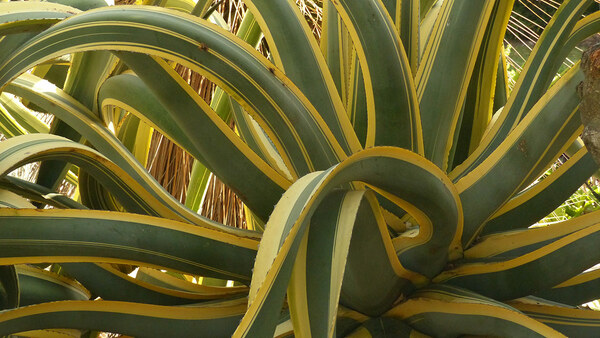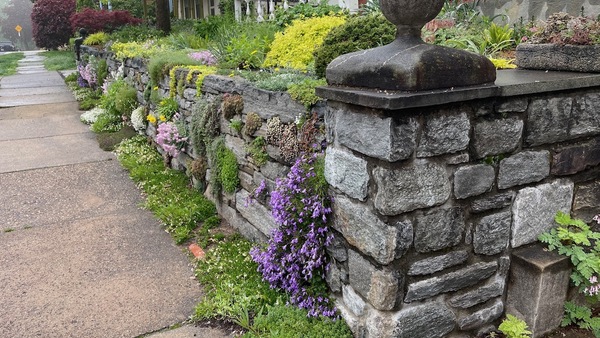
What happens when an avowed plant collector puts down roots on a blank garden slate? When I purchased my property, the small lot in a Zone 5b/6a Denver suburb had little to offer. Aging Siberian elm trees (Ulmus pumila, Zones 4–9) leaned ominously over the house and the street. In the front yard, withering tree seedlings competed with an exhausted bluegrass lawn. The sides of the yard sloped awkwardly, with a few loose landscape timbers stabilizing the grade, and a concrete drive to nowhere split the weedy backyard down the middle. Still, the slope presented opportunities, and the loamy soil wasn’t bad, so I began my transformation. Usually when you think of a “collection” of many different plants, you think it would look messy. But plant placement, hardscape, and quirky garden elements help to coalesce this garden into one coherent design.

The Plan: Big drama in a small suburban garden
This lot, which is 7,200 square feet, left a lot to be desired when I first moved in. After a covered front porch was rehabilitated in the shady front yard, the existing hardscape was overhauled. Concrete walks were covered in red flagstone and created tight pathways throughout the garden. In the backyard, they lead up to the terrace and down toward the pond, which is also adjoined by a seating area. Another seating area is situated on the top of a slope in the north of the garden, near a brick pathway leading to the front. These elements make the most of the garden, leaving plenty of room for plants while also making it a livable space.

Discover the plants Dan uses to give his garden cohesion:6 Knitter Plants That Can Tie a Garden Together |
Interconnected hardscaping unifies the space

Taking on the challenges of a fixer-upper home is not for the faint of heart. In this case, the Southwest theme to the hardscape emerged early. Take the stucco house from a dull beige to a warm terra-cotta: check. Replace doors and windows: check. Redesign and build a covered front porch: check. Once these tasks were accomplished, it was time to decide on hardscape materials. I settled on red flagstones that echo the hues of the stucco and recycled red bricks that exhibited a similar tone to that of the natural stones.
Designing and installing the hardscape for the garden was organic but required a lot of groundwork at the beginning. The dangerous trees went first, leaving only one adolescent blue spruce (Picea pungens, Zones 2–8) for structure and a spot of shade. The daunting concrete drive was removed from the backyard and replaced by pathways and steps leading down from the front garden on the south side. Slopes were recontoured and large boulders placed to stabilize soil and create microclimates for future planting, providing a series of unifying anchors in strategic locations. A stream and small pond were nestled into the lowest contours of the garden, installed to look as natural as possible. Local red flagstone, a very common material in Denver, capped the patio, steps, and pathways that weave casually between garden beds, giving the area a sense of place. Finally, repurposed bricks became a rustic path along the narrow north side of the house, connecting the backyard to the front yard. These elements give a distinctly southwestern feel to the garden, setting the stage for the diverse groupings of plants.

Create unique plant combinations, then knit the groups together

Every garden has its own set of conditions and microclimates. I use these to guide my plant choice and placement and then connect the vignettes using an array of plants that thrive throughout the garden. The Denver climate can be punishing at times, but with a bit of careful tweaking, the generally dry, sunny conditions of my garden allow for impressive diversity in a small space. In the gently bowl-shaped backyard, the north edge slopes south, catching full sun all year. Snow barely lasts a day or two, and many years the ground hardly freezes. Thompson’s yucca (Yucca thompsoniana, Zones 5–11), penstemons (Penstemon spp. and cvs., Zones 4–10), and bearded irises (Iris spp. and cvs., Zones 3–9) fill the slope below Colorado pinyons (Pinus edulis, Zones 4–8; photo below). These drought-tolerant and fragrant pines buffer north winds while adding an evergreen backdrop to the more textural succulent and xeric foreground plantings.
By contrast, the south edge slopes north, shaded by the neighbor’s house, fence, and evergreens. In winter this slope retains snow for weeks at a time and is the slowest part of the garden to warm up each spring. While this area does get some sun, ferns, tree peonies (Paeonia suffruticosa cvs., Zones 4–8), and hostas (Hosta spp. and cvs., Zones 3–8) thrive in the shady sections. Moisture is retained longer here, and this selection of plants has a decidedly more woodsy feel to it.


As a plant collector, I am easily seduced by new or uncommon plants, and they often get prime locations with their preferred conditions in mind. Create some drainage or provide extra moisture to any location, and the plant possibilities are expanded. Agaves (Agave spp. and cvs., Zones 5–11) and cacti are placed in a hot microclimate on the south face of a boulder in the center of the garden where good drainage and full sun suit them, while miniature bearded irises thrive along the lowest edge of that slope. A warm, rugged slope supporting succulent desert plants, with a wetter area below supporting leafier riparian plants, is a common theme here in the West. I embrace a more traditional aesthetic in the front garden, where an array of woodland wildflowers and a low boxwood hedge (Buxus spp. and cvs., Zones 4–9) thrive.
Despite the myriad vignettes throughout my property, there are unifying elements. A suite of plants that are especially adaptable fills the gaps and knits various plantings together, each adding its own textural complement to the wildly divergent cast of main characters. The vertical foliage of bearded irises repeats throughout the landscape, adding voluptuous splashes of color for weeks each May and June. Hens and chicks cluster along dry edges, between rocks, and among perennials with their waxy succulent rosettes. Thyme (Thymus spp. and cvs., Zones 5–9) creeps along boulders and softens flagstone cracks. Yuccas (Yucca spp. and cvs., Zones 4–10) add sculptural elements in various spots, while penstemons self-seed throughout all of the beds.


Garden elements create a sense of place and connect plantings
Plants are not the only things I collect and use to tie various parts of the landscape together. The Southwest climate and dramatic landscapes we enjoy seem to grant wide permission for a gardener to embrace the quirky. And almost anything—rocks, driftwood, metal sculptures, pottery, and even found antlers—can be fair game for use as garden enhancement. The elk antlers resting on the boulder in the center of the garden were found on a steep hillside during my first days in Colorado, bringing to mind the exciting early wonder of living in a spectacular new region. Weathered and twisting juniper logs shelter cacti and yuccas and evoke the Red Rock Canyon landscapes and my favorite trails in Utah. Spiraling arcs of metal spring out of the slope much as a yucca would, sometimes reminding visitors of a dust devil whirlwind. Skull-shaped beads adorn the black-tipped spines of Parry’s agave (Agave parryi, Zones 5–10) in the center of the garden. As the agave grows and new leaves emerge, the beads are pushed to the exterior of the plant, so I occasionally move them back to the center.

These pieces of decor placed deliberately throughout give the garden character and a sense of place while adding another element of continuity. Combined with a cohesive hardscape and a few repeating plants, they bring together what would otherwise be a disjointed landscape.
Tip: Recycle hardscape sustainably
Renovating an older property with failing or outdated hardscape features has its particular challenges. When I purchased the house, an old-school brick incinerator lay in the backyard, which was dominated by an unusable concrete driveway 10 feet wide and 60 feet deep. It ran down the middle of what would become the garden. Old landscape timbers were being used to shore up the slope in the backyard. How much should just go to the landfill, and how much might be repurposed? In my case, I saw these items as assets. The dismantled bricks made a rustic access path down the narrowest edge of the property (pictured). Slabs of broken concrete were pieced together to form the foundation of terraced steps and pathways throughout the garden and were later capped with red flagstone. Old timbers went to the back alley as a platform for trash and recycling containers. About two-thirds of these original materials were able to be repurposed on-site.
Dan Johnson gardens in Arizona and Colorado. He is associate director and curator of native plant collection at Denver Botanic Gardens and is the Southwest regional reporter and forum moderator for FineGardening.com.
Photos, except where noted: Diana Koehm





















Comments
Log in or create an account to post a comment.
Sign up Log in